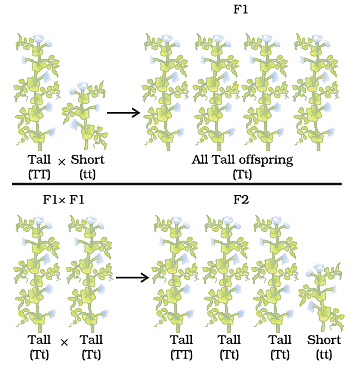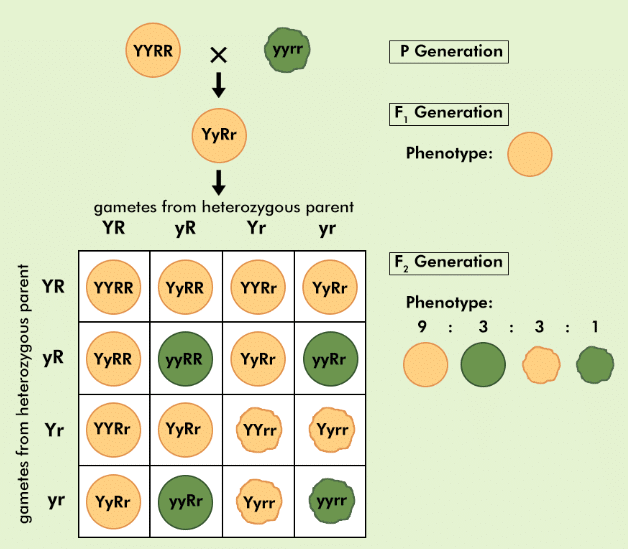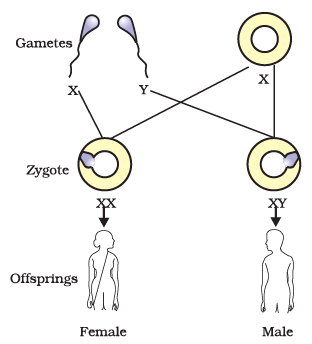Diagram Based Questions: Heredity | Science Class 10 PDF Download
Q1: Answer the following questions based on the diagram given below:

(i) What is a monohybrid cross, and why is it important in the study of genetics?
Ans: A monohybrid cross is a genetic experiment that involves the mating of two individuals that differ in only one trait, typically with one being dominant and the other recessive. It helps us understand how traits are inherited from one generation to the next.
(ii) In the monohybrid cross experiment, what do the letters 'P' and 'F1' represent?
Ans: In the monohybrid cross experiment:
- 'P' represents the parental generation, which consists of the two original individuals being crossed.
- 'F1' represents the first filial generation, which is the offspring resulting from the mating of the parental generation.
(iii) What is meant by the terms 'dominant' and 'recessive' in the context of monohybrid crosses?
Ans: In monohybrid crosses, a 'dominant' trait is expressed when present, while a 'recessive' trait is only expressed when both alleles for the trait are recessive (homozygous recessive). Dominant traits mask the expression of recessive traits.
(iv) If you cross two individuals with the genotype 'TT' and 'tt' for a particular trait, what will be the genotype of their offspring in the F1 generation?
Ans: In the F1 generation, the offspring will have a genotype of 'Tt.' This is because one parent has two dominant alleles ('TT'), and the other parent has two recessive alleles ('tt').
(v) What is the expected phenotypic ratio in the F2 generation if you cross two heterozygous individuals ('Tt') from the F1 generation?
Ans: When two heterozygous individuals ('Tt') from the F1 generation are crossed, the expected phenotypic ratio in the F2 generation is 3:1. This means that three-quarters of the offspring will exhibit the dominant trait (expressing 'T'), and one-quarter will exhibit the recessive trait (expressing 't').
Q2: Answer the following questions based on the diagram given below:
(i) What is the experiment about?
Ans: The experiment is about studying the inheritance of two separate traits, specifically the shape and color of seeds in pea plants.
(ii) How do genes control characteristics or traits in organisms?
Ans: Genes control characteristics or traits by providing instructions for making proteins. These proteins, in turn, influence specific traits such as plant height or seed shape and color.
(iii) How does sexual reproduction ensure that both parents contribute to the traits of their progeny?
Ans: Sexual reproduction ensures that both parents contribute equally to the traits of their progeny by each parent providing a copy of the same gene. This is because germ cells (sperm and egg cells) have only one set of genes, ensuring the mixing of genetic material from both parents during fertilization.
(iv) Why is it important for germ cells to have only one set of genes?
Ans: Germ cells have only one set of genes to ensure that when they combine during fertilization, the progeny receives the normal number of chromosomes with a mix of genetic material from both parents. This ensures genetic diversity and the stability of the species' DNA.
(v) How does the independent inheritance of traits, as shown in the experiment, work?
Ans: Independent inheritance of traits occurs because genes are located on separate independent pieces called chromosomes. When germ cells combine, they bring together chromosomes from both parents, allowing traits like seed shape and color to be inherited independently, as observed in the experiment.
Q3: Answer the following questions based on the diagram given below:
 (i) In the diagram, what are the two types of sex chromosomes shown in human beings?
(i) In the diagram, what are the two types of sex chromosomes shown in human beings?
Ans: The two types of sex chromosomes shown are X and Y chromosomes.
(ii) Based on the image, which parent determines the sex of the offspring in humans?
Ans: The father determines the sex of the offspring by contributing either an X or a Y chromosome.
(iii) What is the significance of the pink and blue colors in the diagram representing the chromosomes?
Ans: The pink color represents X chromosomes, and the blue color represents Y chromosomes. These colors indicate the different types of sex chromosomes.
(iv) How is the sex of a baby determined by the combination of X and Y chromosomes shown in the diagram?
Ans: If an X chromosome from the mother combines with an X chromosome from the father (XX), the baby will be female. If an X chromosome from the mother combines with a Y chromosome from the father (XY), the baby will be male.
(v) What is the probability of having a male or female child based on the information provided in the diagram?
Ans: The probability of having a male (XY) or female (XX) child is 50%, as it depends on whether the father contributes an X or a Y chromosome.
|
80 videos|569 docs|80 tests
|
FAQs on Diagram Based Questions: Heredity - Science Class 10
| 1. What is heredity? |  |
| 2. How is heredity determined? |  |
| 3. What are alleles in heredity? |  |
| 4. How does heredity explain genetic disorders? |  |
| 5. Can heredity be influenced by environmental factors? |  |





















